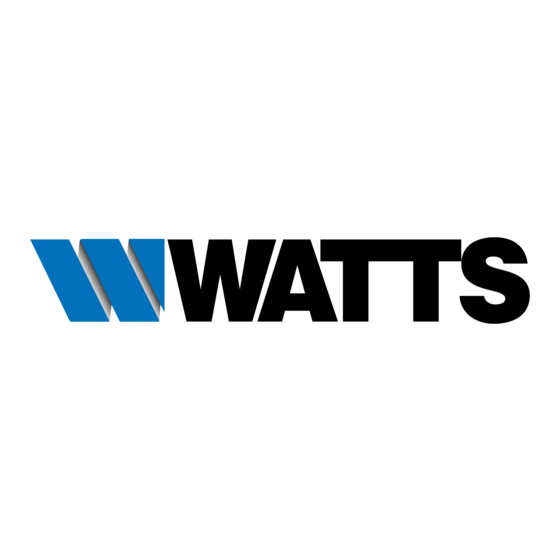
Table of Contents
Advertisement
Quick Links
Advertisement
Table of Contents

Summary of Contents for Watts nexa
- Page 1 User Guide Connection Kit...
-
Page 2: Table Of Contents
Connecting to Nexa ........ -
Page 3: Overview
• Cable ties • AA batteries (2) for transceiver box Associated Hardware Note: A Keyence® flow meter is required for each installation of a Nexa Connection Kit. The following items are packaged separately. • Keyence water flow meter • Nexa Dual Gateway or Ethernet Gateway Tools Required •... -
Page 4: Prerequisites
The measuring pads may become damaged which requires a return to the factory for repair. • Set up Nexa Dual Gateway or Ethernet Gateway before you install the included AA batteries into the transceiver box. When the transceiver is powered on, it automatically attempts to pair with the nearest gateway. -
Page 5: Installing The Flow Meter And Connection Kit
Installing the Flow Meter and Connection Kit While the flow meter has to be installed on the pipe to be measured for flow, the Connection Kit can be installed either on the same pipe or on a nearby wall within cable length. -
Page 6: Attach The Power Cable
GFCI reset or breaker at the panel. Install the Batteries Be sure the Nexa Dual Gateway or Ethernet Gateway is set up before you install the included AA batteries into the transceiver box. When the transceiver is powered on, it automatically attempts to pair with the nearest gateway. -
Page 7: Install The Junction Box And Transceiver
Install the Junction Box and Transceiver You can cable-tie the junction box and transceiver to a pipe or mount it to a flat surface with the included industrial strength Velcro. Depending on the requirements of the install location, the transceiver box can be installed in one of two ways: stacked atop of the junction box or mounted separately directly above the junction box. - Page 8 1. Using the included cable ties, mount the junction box portion first. The transceiver box cable can support its own weight hanging but could be damaged if the weight of the junction box were hanging on it. 2. Feed the cable ties through the mounting holes on top and bottom then fasten the ties securely around the pipe.
-
Page 9: Finish The Installation
Mount to a Surface The transceiver box and junction box can be mounted in a stacked or separate formation. Stacked formation with transceiver Separate formation with transceiver box atop the junction box box above the junction box 1. Clean the desired mounting surface for proper adhesion of Velcro. Oily or dusty surfaces need to be clean and dry. -
Page 10: Connecting To Nexa
Nexa. After the sensors are registered and connected to Nexa, they are listed on the sensor page, as shown below. Each record includes the sensor name, location, type, last reading, last reading time, and manufacturer ID. -
Page 11: Faqs/Troubleshooting
• If gateway signal is too weak, you may need to deploy an additional gateway closer to the sensor to ensure more consistent signal. • If a specific sensor has issues, the Nexa team will ship a replacement sensor to you. Depending on the complexity of the installation, the Nexa team can remotely support you to replace the sensor, or schedule a service visit for the Nexa team to replace the sensor. -
Page 12: Security Protocols
Advanced Encryption Standard (AES)-128 Cipher Block Chaining (CBC) for sensor data messages). Beyond the encryption, data transmissions are also structurally verified and CRC checked before passing up to Nexa or down to the sensor. This ensures the integrity of the data. -
Page 13: Certifications
Approved Antennas All Nexa sensors contain FCC ID: ZTL-G2SC1. The devices have been designed to operate with any one of the approved antennas (listed below), having a maximum gain of 14 dBi. Antennas having a gain greater than 14 dBi are strictly prohibited for use with this device. - Page 14 Canada (IC) English Under Industry Canada regulations, this radio transmittermay only operate using an antenna of a type and maximum(or lesser) gain approved for the transmitter by Industry Canada. To reduce potential radio interference to other users, the antenna type and its gain should be so chosen that the equivalent isotropically radiated power (EIRP) is not more than that necessary for successful communication.
- Page 15 Notes...
- Page 16 Limited Warranty: Watts Regulator Co. (the “Company”) warrants each product to be free from defects in material and workmanship under normal usage for a period of one year from the date of original shipment. In the event of such defects within the warranty period, the Company will, at its option, replace or recondition the product without charge.



Need help?
Do you have a question about the nexa and is the answer not in the manual?
Questions and answers